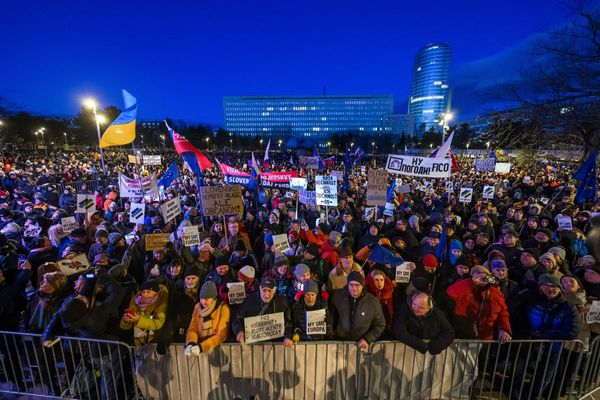
At half-past midnight on May 14, the Israel Defense Forces (IDF) tweeted that its air and “ground troops” were attacking Gaza, a tiny strip of land populated by around 2 million Palestinians living cheek by jowl in cramped housing. The tweet caused many journalists to report that a ground invasion has started. But in a few hours came a swift clarification by the IDF that there had been some “miscommunication” and that the ground troops were still on the periphery of Gaza and had not marched in.
The midnight tweet, however, was not a bureaucratic misunderstanding but rather a ruse to cause panic among Hamas’s cadres, to draw them out of their dens and kill a large number in one go. It worked, the Israeli press reported. Hamas’s anti-tank crew was lured to the massive underground network of tunnels, referred to as “the Metro,” where Hamas buried its stockpiles. They were preparing for the supposed ground incursion and for their own counterattack, but as soon as they were in the tunnels they were bombarded by 450 missiles within minutes. “We struck 150 targets and damaged many kilometers of the Hamas ‘Metro’ network,” the IDF boasted at 9 a.m. that morning.
The Israeli military is playing it up as a major gain, and some are hoping that it might usher the beginning of the de-escalation of the recent crisis. So far, however, neither side has announced a cease-fire and, as Hamas is still responding to Israeli airstrikes with rockets, the Israelis say the option of a ground offensive is still on the table.
According to former Israeli generals, intelligence officers, and defense experts who spoke to Foreign Policy, the Israeli army has three options at this stage in the conflict. It could carry out more attacks from outside Gaza, such as the one on Thursday night, and perhaps destroy a few high-value targets. It could order a limited invasion, as it has done in 2009 and 2014 to destroy specific Hamas facilities. Finally, it could reconquer Gaza, as it had in the Six-Day War in 1967, until the Palestinian Authority was to be ready for a transfer of power.
This last option is militarily coherent but politically infeasible. Everyone seems to agree that Hamas’s total disarmament and destruction are only possible through a prolonged presence of Israeli boots on the ground. But there is little appetite in Israel for a large-scale, long-term, and bloody invasion of the Gaza Strip.
Michael Armstrong, an associate professor of operations research at Brock University in Canada who has been researching the operational performance of weapons built by Hamas (with technological know-how from Iran), said unless Israel occupies Gaza it is impossible to disarm the group. “If they are inside Gaza they can destroy the manufacturing facilities where large- to medium-range rockets are built and try to find any hidden stockpiles,” he said. “But Hamas has shown it can rebuild its destroyed capacities, so unless Israelis want to stay in Gaza and occupy it, I can’t really see how they would disarm it.”
There is a plan in place for the ground offensive; it entails taking one neighborhood at a time. The ground troops, supported by airpower, would find and kill Hamas’s fighters and find and destroy rockets scattered across Gaza (including those buried under places like schools and mosques), while a unit dedicated to informing civilians of airstrikes would warn people beforehand to evacuate their premises. Once the territory had been taken, the IDF would destroy Hamas’s offices and arms manufacturing factories, and assassinate its leaders.
But such an occupation would lead to a bloodbath—a counterproductive one. Experts say it better serves Israel to contain rather than destroy Hamas.
Retired Col. Eran Lerman, a former deputy national security advisor of Israel, said even though Israeli forces have the capacity to conquer Gaza, and it is an option if Hamas does not stop firing rockets, it is not a decision that would serve Israel’s interests, all things considered. “It would mean cutting the strip into pieces, focus on areas dominated by Hamas, find their silent operatives and hidden rockets. But it is going to be a very bloody affair,” he said. “Success in such a campaign would also call for presence for an indeterminate period of time.”
Hamas’s fighters will die, but so will civilians and Israeli soldiers. In addition to high casualties, there is an imminent fear of a lethal insurgency. In Gaza, people support Hamas even when they know that its actions invite Israeli wrath and are a constant threat to their safety. Moreover, running Gaza and rebuilding it would then become Israel’s responsibility, while it would be treated as an occupying power by the locals and the international community. There would be a considerable economic burden, too, and the added concern that a power vacuum could be exploited by extremists. The Palestinian Authority run by Mahmoud Abbas that governs the West Bank has neither the security apparatus required to manage the trouble in Gaza nor any legitimacy among its residents. It will lose the little credibility it has if it were to be handed Gaza by the Israelis.
“Hamas’s capabilities must be destroyed but not to zero, that has been our idea,” Lerman added. “Iran and Hezbollah are the bigger threat, and we must remain focused on them.”
One view in Israel is that Hamas serves the purpose of managing an impoverished Muslim population that Israel can occupy but cannot include as citizens, fearing a change in demographics in favor of Palestinians. Israel exited Gaza after nearly four decades of occupation in 2005, playing it as a generous gesture but in fact using it to procrastinate a genuine peace process and resolution to the conflict.
Shmuel Bar, a former Israeli intelligence officer, said those calling for an invasion to disarm Hamas might change their view if they were told that thousands of Israeli soldiers would die, too. “Nobody really wants a ground offensive, which would mean taking over also the needs of the people and [dealing] with the day-to-day insurgency,” Bar said. “The only people calling for a ground offensive are the extreme religious right who don’t know what it means, because they have never been in the army.” He agreed with Lerman and said the best deterrent against Hamas is to keep it weak and periodically destroy its capabilities.
Israel has undertaken a series of limited ground invasions since walking out of Gaza in 2005. In response to Hamas’s rocket fire in 2009, the IDF launched Operation Cast Lead, a ground incursion to stop arms smuggling into Gaza. In 2014, Israel again went inside Gaza to destroy Hamas’s tunnels into Israel in an effort it called Operation Protective Edge, which lasted 50 days and claimed more than 2,000 Palestinian and more than 70 Israeli lives.
If Israel decides on a short-term incursion, lives would still be lost, and many are asking if it is indeed needed. The general view among Israelis is that Hamas has already lost, as the 1,800 rockets it fired killed six people in all, while some 200 Palestinians have died.
Jonathan Spyer, a British Israeli analyst, said the preferred course for Israel would be to carry on attacking Gaza from the outside and weave a narrative of victory. He said all sides can show they have got something and end the conflict. “The attack on Hamas’s Metro is being recorded as a major achievement already, and I think that the IDF would like to have another one or two or three of those and then call a cease-fire,” Spyer said. Hamas, too, can rest easy, as it has risen in the estimation of many Palestinians by responding to the desecration of Al-Aqsa Mosque.
And yet the end is not in sight. More than 197 Palestinians, including 58 children, have died as Israeli generals use disproportionate force to teach Hamas a lesson and Hamas’s leaders sit in the comfort of Doha, Qatar, and give speeches.







